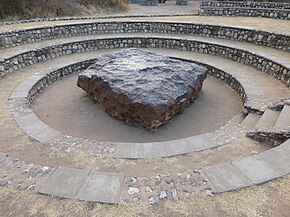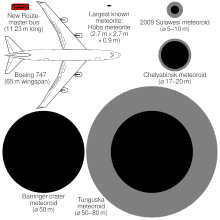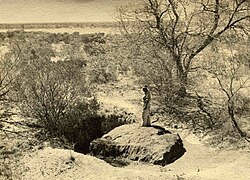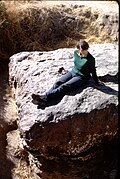Hoba meteorite
| Hoba | |
|---|---|
 The meteorite in 2014 after becoming a tourist attraction | |
| Type | Iron |
| Class | 12 |
| Country | Namibia |
| Coordinates | 19°35′32″S 17°56′01″E / 19.59222°S 17.93361°E |
| Fall date | Less than 80,000 years ago |
| Found date | 1920 |
The Hoba
Impact
The Hoba meteorite is thought to have impacted Earth less than 80,000 years ago. It is inferred
Discovery

The Hoba meteorite left no preserved crater and its discovery was a chance event. In 1920,[1] the owner of the land, Jacobus Hermanus Brits, encountered the object while ploughing one of his fields with an ox. While working the field, he heard a loud metallic scratching sound and the plough came to an abrupt halt. The obstruction was excavated, identified as a meteorite and described by Mr. Brits, whose report was published in 1920 and can be viewed at the Grootfontein Museum in Namibia.
Friedrich Wilhelm Kegel took the first published photograph of the Hoba meteorite.[5]
Description and composition
Hoba is a tabular body of metal, measuring 2.7×2.7×0.9 m (8 ft 10 in×8 ft 10 in×2 ft 11 in). In 1920, its mass was estimated at 66 tonnes. Erosion, scientific sampling and vandalism reduced its bulk over the years. The remaining mass is estimated at just over 64 tonnes. The meteorite is composed of about 84% iron and 16%
Modern history
In an attempt to control relocation attempts, with permission from the farm owner, Mrs O Scheel,[6] on March 15, 1955, the government of South West Africa (now Namibia) declared the Hoba meteorite to be a national monument. Since 1979 the proclamation has been extended to an area of 425 m².[7]

From about the 1970s, development of the meteorite site for tourism was hampered by its location in the Otavi triangle of Otavi, Tsumeb and Grootfontein,
In 1987, the farm owner donated the meteorite and the site where it lies to the state for educational purposes. Later that year, the government opened a tourist centre at the site.[7] As a result of these developments, vandalism of the Hoba meteorite has ceased and it is now visited by thousands of tourists every year.
Nevertheless, specimens sourced from earlier theft and vandalism continue to be traded. On the 7th of December 2021, an unusually large 2.8 kg specimen illegally harvested in 1968, was sold for $59,062 [9] in Los Angeles, by international auction house Bonhams. The Bonhams sale notice states " the present specimen was obtained in 1968 by the father of the present owner when he visited the main mass of Hoba together with some friends. Using a hand saw, they cut a large block of the meteorite from the main mass "as a souvenir", an activity which took them between three and four hours", [9].
-
meteorite in 1950s illustrating its remote and unprotected location.
-
A woman sitting on the meteorite in 1967
-
166 kg (365 lb) meteorite at the previously incorrectly labelled as Hoba.
See also
Notes and references
- ^ a b c Meteoritical Bulletin Database: Hoba
- OCLC 39210190.
- ISBN 978-99916-0-654-5.
- ISBN 978-1-84800-156-5
- (PDF) from the original on 2016-12-15.
- ^ ISSN 0016-7037.
- ^ ISBN 9991605932.
- ^ Lelyveld, Joseph (August 1982). "Inside Namibia". The New York Times.
- ^ a b "Bonhams : HOBA IRON METEORITE--A CUT BLOCK OF TRIANGULAR, PRISMATIC FORM".
- ^ "Meteorite 1303720".
Further reading
- Universe: The Definitive Visual Dictionary, Robert Dinwiddie, DK Adult Publishing, (2005), pg. 223.
- Spargo, P. E. (2008). "The History of the Hoba Meteorite Part I: Nature and Discovery" (PDF). Monthly Notes of the Astronomical Society of Southern Africa. 67 (5/6): 85–94. Bibcode:2008MNSSA..67...85S. Retrieved 2018-07-24.
- Spargo, P. E. (2008). "The History of the Hoba Meteorite Part II: The News Spreads" (PDF). Monthly Notes of the Astronomical Society of Southern Africa. 67 (9/10): 166–177. Bibcode:2008MNSSA..67..166S. Retrieved 2018-07-24.
- Spargo, P. E. (2008). "The History of the Hoba Meteorite Part III: Known and Loved by All" (PDF). Monthly Notes of the Astronomical Society of Southern Africa. 67 (11/12): 202–211. Bibcode:2008MNSSA..67..202S. Retrieved 2018-07-24.



![166 kg (365 lb) meteorite at the National Trust's Tatton Park. Identified as a Gibeon (meteorite),[10] previously incorrectly labelled as Hoba.](http://upload.wikimedia.org/wikipedia/commons/thumb/0/09/Tatton_Park_2016_205_%284x3%29.jpg/240px-Tatton_Park_2016_205_%284x3%29.jpg)